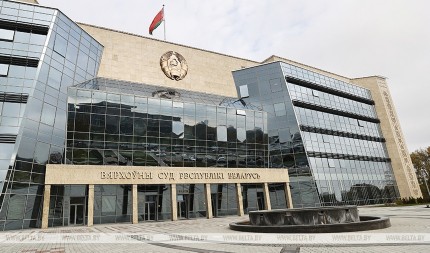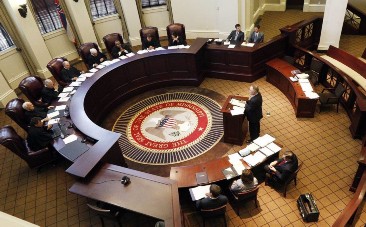| ||||||||||||||||||||||||||||||||||||||||||||||||||||||||||||||||||||||||||||||||||||||||||||||||||||||||||||||||||||||||||||||||||||||||||||||||||||||||
|
|
| |||||||||||||||||||||||||||||||||||||||||||||||||||||||||||||||||||||||||||||||||||||||||||||||||||||||||||||||||||||||||||||||||||||||||||||||||||||||
|
ТЕМА 6. Отправление правосудия
Unit 6
Administration of justice
A court is a tribunal established to administer justice under the law. It may hear civil or criminal cases. The court may award damages or inflict punishment for crimes. There are two different levels of courts: trial courts and appellate courts. A trial court is the first court to hear a case. An appellate court reviews decisions of a trial court when a party claims that an error of law was made at the trial level. Unlike trial courts, appellate courts do not hear witnesses or accept new evidence. They examine the transcript - the word-for-word written record of what was said at the trial. There are two main parties in a civil trial: a plaintiff and a defendant. The plaintiff is the person who brings a suit against the defendant in a court of law. It is his/her job to prove that the defendant is liable. The defendant is the other party in civil proceedings. In a criminal trial the parties are a prosecutor and an accused (the person charged with committing a crime). The prosecution (or the counsel for the prosecution) is the party responsible for presenting the case against the accused in criminal proceedings. A prosecutor's principal role is to prosecute the accused according to the law and the principles of fairness. The counsel for the defence (a barrister, a lawyer, an attorney, an advocate,) is the party which proves that the accused is not guilty. A judge is a person who presides over the court. A judge conducts a trial, hears all witnesses and evidence presented by both parties, and then passes a sentence – a decision on the case based on the interpretation of the law. The main role of a judge is to see that the rules of court procedures are followed by both parties. As for a jury, a jury is a body of ordinary people (typically twelve in number) selected at random to decide the facts of the case and bring a verdict. The jury decides whether a defendant is "guilty" or "not guilty" in criminal cases, and "liable" or "not liable" in civil cases. The jury returns a verdict which must be unanimous. All jury discussions must occur in the jury room and only when all jurors are present. If the jurors are unable to reach agreement, the case must be retried before a new jury. Witnesses provide testimony, under oath, as to what they have seen, heard or otherwise observed regarding the case. They are examined and cross-examined by the attorneys and may be questioned by the judge. If a witness makes false claims while under oath, he/she can be charged with perjury, which is itself a crime. All these participants work to ensure that the court is fair and impartial.
A Exercise 1. Give the English for: в соответствии с законом, рассматривать уголовное дело, назначать наказание за преступление, свидетель, доказывать вину, пересматривать решения суда первой инстанции, заявлять о судебной ошибке, сторона по делу, гражданские и уголовные дела, принимать новые улики, адвокат, апелляционный суд, судья, ответчик, устные аргументы, доказывать чью-либо вину, клясться принимать решения на основании фактов, прокурор, созывать суд присяжных, представлять различные слои общества, необоснованные обыски, свобода слова, независимость судопроизводства.
Exercise 2. Match English and Russian equivalents:
Exercise 3. Complete the sentences: 1) There are two different levels of courts … 2) Unlike trial courts, appellate courts do not hear ... . 3) An appellate court sometimes reviews ... . 4) Then the appellate courts listen to ... . 5) The jury is composed of ... . 6) The jury listens to ... . 7) The jury decides whether a defendant is ... . 8) To guarantee rights like ... .
Exercise 4. Agree or disagree: 1) Court may hear civil or criminal cases. 2) The words trial and judge are often used to mean the same thing. 3) A trial court sometimes reviews decisions of an appellate court. 4) Unlike trial courts, appellate courts do not hear witnesses or accept new evidence. 5) The trial court examines the transcript – the word-for-word written record of what was said at the trial 6) Judges don’t arrest people or try to prove them guilty. 7) The role of the Judge is to see that the rules of court procedures are followed by both sides. 8) Decisions are based on what is popular at the moment, not what is right and just under the law.
Exercise 5. Answer the questions: 1) What is a court? 2) What does a trial court consist of? 3) What court is the first court to hear a case? 4) What is the main function of an appellate court? 5) Do appellate courts hear witnesses or accept new evidence? 6) What does a judge do? 7) Why is a jury summoned? 8) What decisions does the jury make? 9) What ensures the independence of the court?
B
Exercise 1. Tell what you are doing now; what you do every day using the following expressions: To try a case; to preside over the court; to hear an appeal; to collect evidence; to interview a victim; to make a record; to search a house.
Exercise 2. Open the brackets and use Indefinite (Present, Past, Future) or Continuous (Present, Past, Future) Tenses: 1) The case (to try) now. 2) The investigator (to interrogate) a criminal from 3 till 5 yesterday. 3) The jury (to pass) its verdict in two days. 4) The man (to drive) his car slowly when I (to see) him. 5) Don’t enter. The problem on juvenile delinquency (to discuss).6) The Court of Appeal (to hear) 10 appeals yesterday. 7) The Court of Appeal (to sit) in both civil and criminal divisions. 8) This judge (to preside) the following sitting of the court.
Exercise 3. Put 5 different questions to the following sentences: 1)Violent crime is rising constantly in the USA. 2) A number of measures to strengthen the criminal justice system were being taken by the Government for a few years. 3) The judge decides law questions.
C
Exercise 1. Read and translate the text:
The English Judicial System
At the present time the English judicial system is basically pyramidal in organization. At the top of the pyramid there is one final appellate tribunal, the House of Lords. Appeals are referred to the Appellate Committee of the House. Beneath the Supreme Court there is the Court of Appeal. The Court of Appeal sits in both civil and criminal divisions. Beneath these appellate courts there are two separate systems of trial courts, one for criminal cases and the other for civil cases. On the civil side there is the High Court, a court of general jurisdiction, and the County Courts, which have only limited jurisdiction. On the criminal side there is the Crown Court, also a court of general jurisdiction, and the Magistrates’ Courts having only limited jurisdiction. Magistrates' courts consist of a stipendiary magistrate or of from two to seven (usually two or three) lay justices of the peace. Magistrates’ courts have civil jurisdiction in relation to certain debts, licences, and domestic proceedings. Outside of London and a few other large cities the magistrates are laymen, who sit only occasionally to try cases. In the largest cities there are full-time stipendiary magistrates, who must have legal training.
Exercise 2. Read and translate the text:
Judicial power of the Republic of Belarus
By the law the judicial power belongs to the general and other courts with the Supreme Court and the Constitutional Court at the head. The Supreme Court, regional courts, the City of Minsk Court, district (city) courts constitute the system of general courts. The district or city courts are the lowest ones in the general court system. They are established in different districts and cities. These courts try a majority of criminal and civil cases and hear cases on administrative offences. Regional courts and the City of Minsk Court form the higher level of the courts of general jurisdiction. They are made up of the Chairman of the court, his deputies and a number of judges, who act in the composition of judicial boards and the Presidium of the court. Economic courts are represented by six regional economic courts and the City of Minsk Economic Court. These courts hear cases in the sphere of economy. The highest court in the system of general courts is the Supreme Court consisting of the Chairman, his deputies and judges acting in the composition of boards (on civil and criminal cases), the Presidium and the Plenum. In the limits of its powers it tries cases as an appellate court when it is provided by law. The Constitutional Court has a unique position in the court system of the Republic of Belarus. It was elected according to the Constitution and the Law on the Constitutional Court of the Republic of Belarus, 2013. The main function of the Constitutional Court is to provide the supremacy of the Constitution of Belarus. It sees to it that laws and acts of state bodies be corresponded to the Constitution. The court ensures the legality in the law enforcement activity and solution of other matters provided by the Constitution.
Exercise 3. Read and translate the text:
The US Judicial System
The federal judiciary and the fifty state judicial systems are each constructed like a pyramid. These systems are similar but they vary in the details of their organization and business. Across the base there are the trial courts, the courts of first instance. At the apex there is the court of last resort, usually called the Supreme court. In most states and in the federal system there is a middle tier, the intermediate appellate courts. Federal courts hear criminal and civil cases involving federal law. They also hear cases involving parties from different states when the amount in dispute is more than $10,000. Federal trial courts are known as U.S. District Courts. If you lose a case in the U.S. District Court, you may appeal to the U.S. Circuit Court of Appeals in your region. The United States has thirteen circuit courts. The court of final appeal is the U.S. Supreme Court. Most state court systems resemble the federal courts in structure and procedure. All states have trial courts. These are called superior courts, county courts, district courts, or municipal courts, depending on the state. State courts are often specialized to deal with specific areas of law, such as family law, traffic law, criminal law, probate, and small claims. If you lose your case in the trial court, you may appeal to an intermediate court of appeals. In some states, the appeal goes directly to the state supreme court. If a state supreme court decision involves only state law, it can be appealed no further. But if it involves some federal law or constitutional issue, it can then be appealed to the U.S. Supreme Court.
D
Administration of justice
| ||||||||||||||||||||||||||||||||||||||||||||||||||||||||||||||||||||||||||||||||||||||||||||||||||||||||||||||||||||||||||||||||||||||||||||||||||||||||
|
| ||||||||||||||||||||||||||||||||||||||||||||||||||||||||||||||||||||||||||||||||||||||||||||||||||||||||||||||||||||||||||||||||||||||||||||||||||||||||
| © Академия Министерства внутренних дел Республики Беларусь Электронный учебно-методический комплекс | ||||||||||||||||||||||||||||||||||||||||||||||||||||||||||||||||||||||||||||||||||||||||||||||||||||||||||||||||||||||||||||||||||||||||||||||||||||||||

 The court system is based on the principles of territoriality and specialization.
The court system is based on the principles of territoriality and specialization.  In the United States the judiciary is divided into the national (federal) and state judiciary.
In the United States the judiciary is divided into the national (federal) and state judiciary.